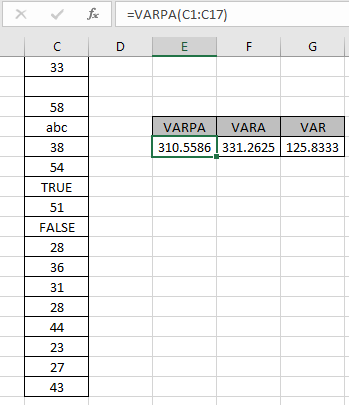
In this article, we will learn How to use the VAR function in Excel.
What is variance of a list of numbers?
VAR function is a statistical function which returns the numerical variance value for the array of data given in as input. In simple words, get the estimated variation of population of the data in Excel using the VAR or related function. The VARPA function considers text values as 0, Logic values TRUE and FALSE as 1 and 0 respectively. Use a VARA or newer VARP function to ignore all other values except numbers.
VAR Function in Excel
VAR function is a statistical function which returns the numerical variance value for the array of data given in as input.
VAR Function Syntax:
| =VARPA(number1,number2,..) |
number : number or array given as cell reference
Different VAR function in Excel and its usage.
| Name | Data set | Text and logicals |
| VAR | Sample | Ignored |
| VARP | Population | Ignored |
| VAR.S | Sample | Ignored |
| VAR.P | Population | Ignored |
| VARA | Sample | Evaluated |
| VARPA | Population | Evaluated |
Example :
All of these might be confusing to understand. Let's understand how to use the function using an example. Here Here we have a array of numbers need to find the variance

Use the formula to get the variance for the range
| =VAR(B2:B10) |

Variance for the following data is 659.74.
Excel VAR function is not used popularly. Excel replaced the use of VAR function with VAR.S is used to get the variance of the data.
Usage of VAR function or related VAR function
Here we have some numbers to test the VARPA function in Excel.
Use the formula:
| =VARPA(C1:C17) |
Here the array of values is given as cell reference. You can also input values as numbers.

Here the function doesn't ignore blank cells, TRUE and FALSE logic values and text values. The VARPA function returns 310.5586 as population variance. The VARA function returns 331.2625 as sample variance considering text values as 0, TRUE value as 1 and FALSE value as 0 whereas VAR function returns 125.8333 as sample data ignoring all other variable types except numbers.
What is the Difference in VAR, VARS, VAR.S (all are same) and VARPA or VAR.P.
The denominatore in VAR, VARS,VAR.S is n-1. Where n is the number of observations. Where VAR.P has denominator n.
| VAR/VARS/VAR.S | VARP/VAR.P |
| =summation[(x-x)2/(n-1)] | =summation[(x-x)2/n] |
VAR.S is used for population data. VAR.P is used for population data.
Here are some observational notes shown below.
Notes:
Hope this article about How to use the ... function in Excel is explanatory. Find more articles on calculating values and related Excel formulas here. If you liked our blogs, share it with your friends on Facebook. And also you can follow us on Twitter and Facebook. We would love to hear from you, do let us know how we can improve, complement or innovate our work and make it better for you. Write to us at info@exceltip.com.
Related Articles :
How to use the VARPA function in Excel : Calculate the variance for the sample data numbers in excel using the VAR function
How to use the VAR.P function in Excel : Calculate the variance for the population data numbers in excel using the VAR.P function
How to use the DVAR function in Excel : Calculate the variance for the sample data numbers having multiple criteria in excel using the DVAR function
How to Use STDEV Function in Excel : Calculate the standard deviation for the data numbers in excel using the STDEV function
How to use the AVERAGE function in Excel : AVERAGE function in Excel takes a data sample and returns the mean or average for the input values in Excel.
How to use the VAR function in Excel : Calculate the variance for the sample data numbers in excel using the VAR function in Excel.
Regressions Analysis in Excel : Regression is an Analysis Tool, which we use for analyzing large amounts of data and making forecasts and predictions in Microsoft Excel.
How to Create Standard Deviation Graph : The standard deviation graph tells how much the data is clustered around the mean of the data. Learn how to plot the standard deviation graph in Excel.
How to Use STDEV Function in Excel : Calculate the standard deviation for the data numbers in excel using the STDEV function in Excel.
How to Find Correlation Coefficient in Excel : The correlation coefficient of a data set is a statistical number that tells how strongly two variables are related to each other. Learn about mathematical formula and relational Correlation function here.
Popular Articles :
How to use the IF Function in Excel : The IF statement in Excel checks the condition and returns a specific value if the condition is TRUE or returns another specific value if FALSE.
How to use the VLOOKUP Function in Excel : This is one of the most used and popular functions of excel that is used to lookup value from different ranges and sheets.
How to use the SUMIF Function in Excel : This is another dashboard essential function. This helps you sum up values on specific conditions.
How to use the COUNTIF Function in Excel : Count values with conditions using this amazing function. You don't need to filter your data to count specific values. Countif function is essential to prepare your dashboard.
The applications/code on this site are distributed as is and without warranties or liability. In no event shall the owner of the copyrights, or the authors of the applications/code be liable for any loss of profit, any problems or any damage resulting from the use or evaluation of the applications/code.